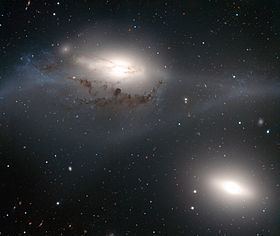Right ascension 12 27 45.6(J2000) Redshift ? Apparent magnitude (V) +10 Magnitude 10 | Declination +13° 00' 31" (J2000) Distance 52 million ly Absolute magnitude (V) 12 | |
 | ||
Similar Markarian's Chain, NGC 4402, NGC 4388, Messier 86, Messier 84 | ||
The Eyes Galaxies (NGC 4435-NGC 4438, also known as Arp 120) are a pair of galaxies about 52 million light-years away in the constellation Virgo. This galaxy takes its name from its ring structure which made it popular.
Contents
NGC 4435
NGC 4435 is a barred lenticular galaxy currently interacting with NGC 4438. Studies of the galaxy by the Spitzer Space Telescope revealed a relatively young (190 million years) stellar population within the galaxy's nucleus, whose origin may have arose through the interaction with NGC 4438 compressing gas and dust in that region, triggering a starburst. It also has a long tidal tail possibly caused by the interaction with the mentioned galaxy; however other studies suggest that tail is actually a galactic cirrus in the Milky Way totally unrelated to NGC 4435.
NGC 4438
NGC 4438 is the most curious interacting galaxy in the Virgo Cluster, due to the uncertainty surrounding the energy mechanism that heats the nuclear source; this energy mechanism may be a starburst region, or a black hole-powered active galactic nucleus (AGN). Both hypotheses are currently under investigation by astronomers.
This galaxy shows a highly distorted disk, including long tidal tails due to the gravitational interactions with other galaxies in the cluster and its companion. The aforementioned features explain why sources differ to classify it as a lenticular or spiral galaxy. NGC 4438 also shows signs of a past, extended, -but modest- starburst, a considerable deficience of neutral hydrogen, as well as a displacement of the components of its interstellar medium -atomic hydrogen, molecular hydrogen, interstellar dust, and hot gas- in the direction of NGC 4435. This observation suggests both a tidal interaction with NGC 4435 and the effects of ram-pressure stripping as NGC 4438 moves at high speed through Virgo's intracluster medium, increased by the encounter between both galaxies.
As interacting galaxies
While there is evidence to suggest that the environmental damage to the interstellar medium of NGC 4438 may have been caused by an off-center collision with NGC 4435 millions of years ago, a recent discovery of several filaments of ionized gas link NGC 4438 with the large neighboring elliptical galaxy Messier 86, in addition to a discovery of gas and dust within M86 that may have been stripped from NGC 4438 during a past encounter between the two. Given the high density of galaxies in the center of the Virgo galaxy cluster, it's possible the three galaxies, NGC 4435, NGC 4438, and M86, have had past interactions.
In popular culture
In the 2014 film Interstellar, "NGC 4438" along with specific observation data can be seen in Murphy Cooper (Jessica Chastain)'s notepad during the film's climactic sequence. As the presence of a supermassive black hole in the AGC of NGC 4438 is one of two leading theories, the galaxy is potentially that accessed by the wormhole in the film.
